Johnny’s No-Flap LASIK (Episode 5) – 4 months follow-up
Johnny’s No-Flap LASIK – (Episode 5) – 4 months after No-Flap LASIK
Johnny first came to the Rand Eye Institute for a vision consultation, to see if he was a Laser Vision Correction(No-Flap LASIK) candidate. He was!
It’s been 4 months since Johnny had his No-Flap LASIK procedure with Dr. Allison L. Rand. Johnny’s had wonderful results! He is now glasses free and can enjoy life without the need for glasses, or contact lenses, to correct his vision.
“For anyone that’s considering (No-Flap) LASIK, I would highly recommend having it here at the Rand Eye Institute.”
- J. Marino
Keeping Your Eyes Healthy
Living an overall healthy life is good for your eyes. You can start taking steps toward living a healthy life by:
Maintaining a healthy weight: Being overweight or obese can increase your risk of developing diabetes and other systemic conditions, which can lead to vision loss, such as diabetic eye disease or glaucoma.
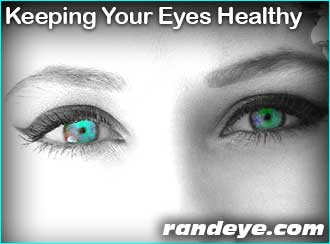
Eating healthy foods: Eating a diet rich in fruits and vegetables, particularly dark leafy greens such as spinach, kale, or collard greens, is important for keeping your eyes healthy. Research has also shown there are eye health benefits from eating fish high in omega-3 fatty acids, such as salmon, tuna, and halibut.
Not smoking: Smoking is as bad for your eyes as it is for the rest of your body. Research has linked smoking to an increased risk of developing age-related macular degeneration, cataracts, and optic nerve damage, all of which can lead to blindness.
Managing chronic conditions: Many conditions, such as diabetes, hypertension, and multiple sclerosis, can greatly impact vision, resulting in inflammation of the optic nerve, diabetic retinopathy, glaucoma, and even blindness. Managing these conditions with the help of your health care provider can often prevent these eye problems from occurring.
Healthy Vision Month
When it comes to our health, we often visit our doctor or nurse regularly to ensure that our bodies are healthy, but what about our eyes? Our eyes are just as important.
During Healthy Vision Month, it is important to be educated about the proper ways to protect your vision.

One of the ways to keep your vision young and working it’s A-Game, is to schedule regular eye checkups and yearly comprehensive eye exams.
While you might think your vision is good enough and that your eyes are healthy, visiting The Rand Eye Institute for a comprehensive dilated eye exam is the only way to be completely certain.
When it comes to common vision problems, many people don’t realize their vision could be improved with glasses or contacts. In addition, many common eye diseases such as glaucoma, diabetic eye disease, and age-related macular degeneration often have no symptoms, so a dilated eye exam is the only way to detect these diseases in their early stages.
During a comprehensive dilated eye exam, drops are placed in your eyes to dilate, or widen, the pupil. At Rand Eye Institute we use a special magnifying lens to examine your retina and look for signs of damage and other eye issues. After the examination, your close-up vision may be blurred for several hours, so it’s recommended that you have someone with you to drive you home.
An annual exam could end up being a life saving event.
Johnny’s No-Flap LASIK Surgery (Part 4) – 1-month LASEK follow-up
“I’m very excited that my eye sight is a lot better than it used to be. It’s not blurry when i wake up in the morning, anymore. I can go to sleep watching tv, without having to worrying about falling asleep with my contacts on, or breaking my glasses when i’m rolling over.
I used to wear contacts for 8 years, before surgery(No-Flap LASIK), and i was so used to the daily routine that even after surgery i find myself thinking that i need to take my contacts out. But i don’t have to any more, and that’s AMAZING!”
- J. Marino
Protect Your Eyes
An unprotected eye is an invitation for an injury to occur, especially while playing sports. But there are so many ways in which we can protect our eyes.
Here are some precautions that should be taken, when playing sports, to prevent eye injuries from happening.
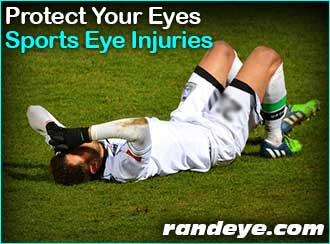
Baseball: Players should wear a faceguard made of a sturdy plastic or polycarbonate material along with eye goggles or eye guards.
Basketball: Players should wear eye goggles at all times in the event of an errant elbow, a stray poke from another player’s finger, or an errantly thrown basketball.
Soccer & football: Like other contact sports, an errant elbow, ball, foot, or finger can cause serious damage to the unprotected eye. Players should always wear sports eye guards and, in football, a full faceguard.
Hockey: Players should wear full polycarbonate material or a wire mask to prevent eye injuries and possible facial injuries.
Tennis or racquetball: To protect your eyes from a ball, or your opponent’s racquet, protective eye goggles should be worn at all times while playing this sport.
Most Common Sports Eye Injuries
The most common types of eye injuries that can result from sports injuries are blunt injuries, corneal abrasions and penetrating injuries
✦ Blunt injuries occur when the eye is suddenly compressed by the impact from an object. Blunt injuries, often caused by tennis balls, racquets, fists or elbows, can sometimes cause a black eye or hyphema (bleeding in front of the eye). More serious blunt injuries often break bones near the eye, and may sometimes seriously damage important eye structures and/or lead to vision loss.
✦ Corneal abrasions are painful scrapes on the outside of the eye, or the cornea. Most corneal abrasions eventually heal on their own, but a doctor can best assess the extent of the abrasion, and may prescribe medication to help control the pain. The most common cause of a sports-related corneal abrasion is being poked in the eye by a finger.
✦ Penetrating injuries are caused by a foreign object piercing the eye. Penetrating injuries are very serious, and often result in severe damage to the eye. These injuries often occur when eyeglasses break while they are being worn. Penetrating injuries must be treated quickly in order to preserve vision
Signs or Symptoms of an eye Injury:
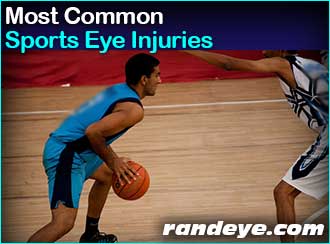
● Pain when looking up and down, or difficulty seeing ● Tenderness
● Sunken eye ● Double vision ● Severe eyelid and facial swelling ●Difficulty tracking ●The eye has an unusual pupil size or shape
● Blood in the clear part of the eye ● Numbness of the upper cheek and gum ● Severe redness around the white part of the eye
Sports Related Eye Injuries – Can Be Prevented
Ouch! It’s all fun and games until someone gets hurt!
Do You Know, that more than 25,000 people are treated for sports-related injuries each year, but there is good news: 90% of those injuries can be prevented!
Here are some tips to increase your injury Eye-Q:
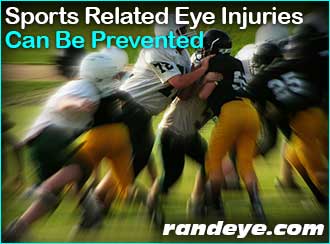
- Always wear proper safety goggles (lensed polycarbonate protectors) for racquet sports or basketball. In order insure that your eyes are protected, it’s important that any eye-guard or sports protective eyewear be labeled as ASTM F803 approved. This eyewear is performance tested to give you the highest levels of protection.
- Use batting helmets with polycarbonate face shields while playing baseball.
- Use helmets and face shields approved by the U.S. Amateur Hockey Association when playing hockey.
- Know that regular glasses don’t provide enough protection.
Know your Eye-Q, not just this month, but all year long, and take care of your eyes and your eye-health.
After Cataract Surgery – Jim’s Interview [HD]
In this interview Jim explains why he chose to treat his Cataract at the Rand Eye Institute. Watch as he discusses his struggles with vision and not being able to see clearly. The options available and what finally made him take the initiative to treat his Cataract to improve his vision.
“I was so glad to have this done, Don’t Wait.”
- Former Fire Chief, J. Mathie.
Simple Tips to Prevent Sports Eye Injuries
Its all fun and games until someone gets hurt!
More than 25,000 people are treated for sport-related injuries each year. But there is good news; 90% of these injuries can be prevented!
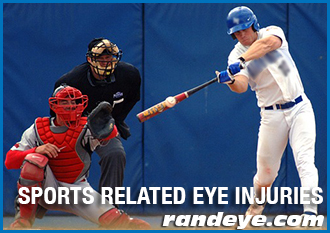
Here are some simple tips to prevent eye injuries:
- Wear proper safety goggles (lensed polycarbonate protectors) for racquet sports or basketball. In order to be assured that your eyes are protected, it is important that any eye guard or sports protective eyewear are labeled as ASTM F803 approved. This eyewear is performance tested to give you the highest levels of protection.
- Use batting helmets with polycarbonate face shields while playing baseball.
- Use helmets and face shields approved by the U.S. Amateur Hockey Association when playing hockey.
- When bike riding wear a helmet and safety glasses, with polycarbonate lenses and UV protection, to shield your eyes from damaging sunlight and debris.
- Know that regular glasses don’t provide enough protection.
Always wear the recommended safety equipment, for the sporting activity you will engage in.
Johnny’s No-Flap LASIK Surgery (Part 3) – 1 Week Post-Op
Johnny’s No-Flap LASIK Surgery (Part 3) – 1 Week Post-Op
Johnny’s excited about his new vision and all the activities he will be able to enjoy without contacts or glasses.
Subscribe or Follow Us, to be notified of upcoming episodes.
